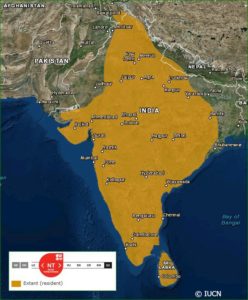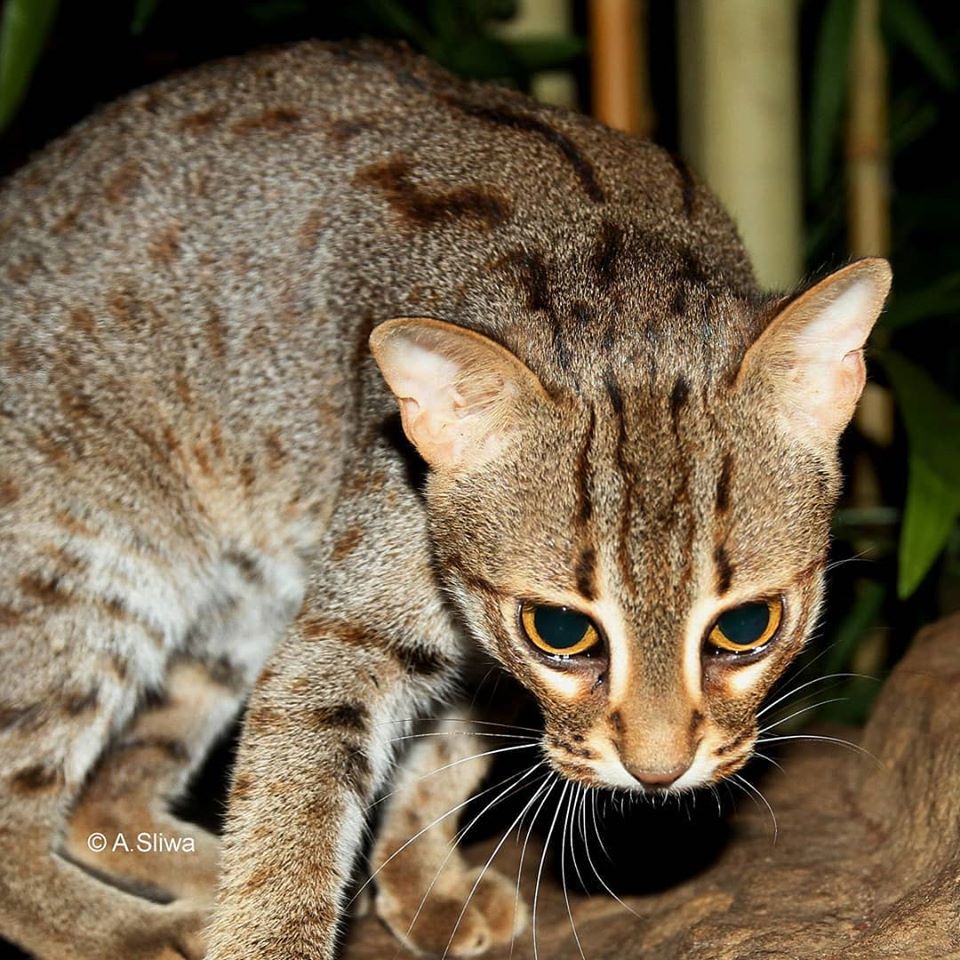
- HB Length: 35-48 cm (13-19″)
- Tail Length: 15-30 cm (5.9-11″)
- Height: Approx. 20 cm (8″)
- Weight: 1-1.6 kg (2.2-3.5 lbs)
- Pop. Trend: Decreasing
Rusty-spotted Cats Prionailurus rubiginosus compete with Black-footed Cats Felis nigripes and the Kodkod Leopardus guigna as the world’s smallest wild cat species. They have been described by some as a smaller, ‘washed out’ version of the Leopard Cat Prionailurus bengalensis.
The body is slender body and smaller than a domestic cat. The fur is short and soft, with the upper parts a grizzled brownish grey, tinged with rufous to varying degrees and marked with rust brown spots. There are horizontal bars on the legs and chest; the belly and inner sides of the legs are white. Their head is short, rounded, and marked with two white streaks on the inner edges of the eyes. There are several reddish brown streaks on each cheek, and the chin and cheeks are white. The eyes are fairly large with irises of greyish brown to amber. Ears are short and rounded, backed with rufous grey, and have light coloured basal ear spots. Their legs are relatively short, and the feet have black soles. The tail is moderately long, more rusty coloured than the body, and unmarked.
Distribution

Found only in India, Sri Lanka and marginally in Nepal, Rusty-spotted cats were previously thought to inhabit only moist forests. Recent records have indicated the cats also occur in dry forest, bamboo forest, wooded grassland, arid scrubland and on rocky hill slopes.
Their presence has been confirmed in the tropical dry Gir Forest of northern India. In Sri Lanka, they are found from sea level to 2,100 metres.
These cats have been discovered living in abandoned houses in a thickly populated area of southern India, distant from forest which has been considered their habitat. It is likely that rats and mice around the houses, and nearby poultry serve as food. Showing some tolerance of modified habitats, females with kittens have been found denning in a tea plantation in Sri Lanka.
Ecology
Very little is known about the lives of these cats, although they are thought to be nocturnal. They have a reputation for being especially fierce hunters taking large prey, but their diet is likely to be small animals, and they are frequently killed for taking domestic chickens.
The 19th century naturalist, T.C. Jerdon, had a Rusty-spotted Cat as a pet, and it would hunt tree squirrels in the rafters of his house. When introduced to young gazelle, the cat immediately seized it by the nape of the neck, and had to be pulled off before it would let go.
Rusty-spotted Cats are accomplished climbers, and probably hunt in trees as well as on the ground. In Sri Lanka, they have been observed near termite hills, especially after a heavy rain, feeding on winged termites.
In Eastern Gujarat, India they were observed in caves, and taking shelter in gaps of big boulders. They hunted by ambush in grass and bamboo thickets, or on big tree branches where they jumped directly onto their prey on the ground. Small rodents that prefer cultivated areas were their main prey, so the cats were found more on the forest edges than in dense cover where the Leopard Cat Prionailurus bengalensis and Leopard Panthera pardus are found. During the monsoon season Jungle Cats Felis chaus moved into Rusty-spotted habitat to prey on amphibians, and the smaller cats kept their distance from their larger cousins.
Reproduction
The reproductive behaviour of Rusty-spotted Cats has been observed in captivity, and is almost identical to that of the domestic cat. Mating lasts from one to five minutes, and can be repeated numerous times a day. Most cats remain in oestrous for about three days, longer if the female is not mated. Breeding is seasonal in captivity, but two wild litters of kittens were both found in February.
A litter of one to three kittens is born in a secluded den after a gestation of approximately 67 days. Newborns weigh less than an egg. The kittens lack the rusty spotting of the adults and their irises are light blue. Nothing is known of their development but it is probably much like that of domestic kittens. Longevity has been reported at 12 years, in captivity.
Conservation
Rusty-spotted cats have always been considered rare, but recent observations suggest they are more common than previously thought. Given their tiny size and ability to control rodents, they can survive if not persecuted by man. However these cats are often mistakenly persecuted as cubs of the Leopard Panthera pardus, hunted for skins or meat and killed by domestic dogs.
The main threat to these small cats is the destruction of their natural habitat due to the needs of the ever growing populations of India and Sri Lanka. Hybridization with feral domestics has also been observed. Nothing is known of the Rusty-spotted Cat’s status in the wild.
Compare with the other two tiny cat species, the Black-footed Cat of Africa and the Kodkod of South America.
Range Map IUCN Red List (2008)
Updated 2016

36 Responses